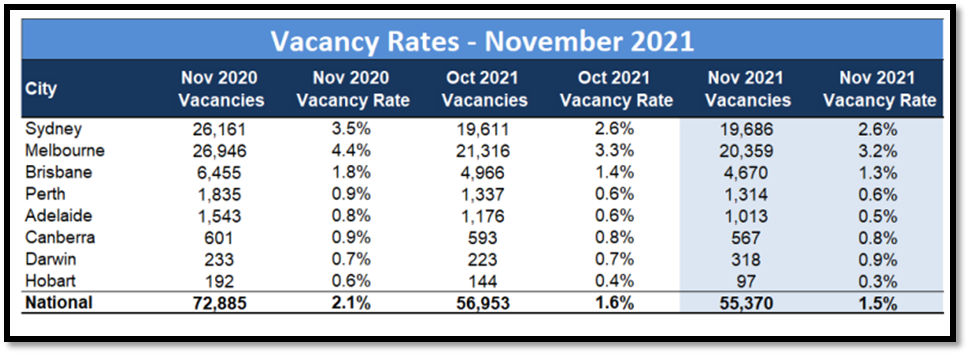
Tenants continued to face fewer rental options in the market as vacancy rates declined in November.
The latest SQM Research report showed the number of vacancies Australia-wide went down to 55,370 in November, representing a 1.5% vacancy rate.
Five of the eight capital cities now have a vacancy rate of below 1%, with Hobart hitting the lowest vacancy rate at 0.3%.
Sydney maintained its vacancy rate at 2.6% but Melbourne and Brisbane recorded further falls in the month to 3.2% and 1.3%, respectively.
SQM Research managing director Louis Christopher said there has not been a time when that many capital cities simultaneously recorded vacancy rates under 1%.
“This has translated into surging rental rises, particularly for houses where the capital city rise for the year is now recorded up by 11.7%,” Mr Christopher said.
“It is clear that demand has boomed for larger properties since COVID and we are not yet recording a reversal of this trend.”

However, Mr Christopher said it is likely that units are going to get more attention next year given the markets relative affordability.
Furthermore, as borders reopen and the inflow of migrants resumes, units are likely the first options to be considered.
Looming rental crisis
BuyersBuyers co-founder Pete Wargent said the rental market is likely to enter crisis territory in many regions.
“Although international travel has come back to some extent, we expect to see a surge in ‘staycations’ this year, as Aussies fear being shut out on return,” Mr Wargent said.
“Travel and flight rules are changing quickly at the moment, and over the coming months, we expect booming rental demand in destinations such as Sunshine Coast, Gold Coast, and the northern New South Wales coast, among others.”
Rental markets are expected to tighten further and would likely end the year with even lower vacancy rates.
“Everything is already full in many of the lifestyle locations, and that’s only going to intensify over the Christmas break.”
“Aussies have built up a huge war chest of savings, an unprecedented $1½ trillion in cash and deposits. We’ve seen the renovations boom; next comes the staycations boom” Mr Wargent said.
BuyersBuyers CEO Doron Peleg said another factor pulling down vacancy rates is the fact that more Australians have already purchased their second homes while regulations have shifted incrementally in favour of tenants.
“As international students return and new migrants begin arriving again, and eventually tourists additionally, we can expect to see rental vacancies falling to record low levels in many suburban and regional locations,” Mr Peleg said.
“CBD vacancies are still elevated in Sydney and Melbourne, and some areas still have a strong supply of new apartments, as documented in our quarterly oversupply report.
“But overall, we expect tight rental markets to persist in 2022 as immigration comes back online, and that’s already reflected in five of the eight capital cities recording vacancy rates of under 1 per cent for the first time”.
—
Photo by Samuel Holt on Unsplash.